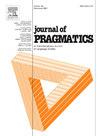主体性与信息结构:普通话口语左右边缘语用学
IF 1.7
1区 文学
0 LANGUAGE & LINGUISTICS
引用次数: 0
摘要
本研究为话语外围的研究提供了一种新的数据驱动分析模型。该模型将信息结构和主体性之间的关系操作化,揭示了说话者如何同时管理沟通的认知和社会方面。使用21个以普通话为母语的人自发的电话对话样本(CallFriend普通话语料库),所有关于和框架主题(Lambrecht, 1994;Frascarelli, 2017)被识别出发生在话语右边缘的话题,并与在话语左边缘产生的同等数量的话题进行了比较。该研究提供了多因素分析,包括指称激活(Chafe, 1987)、主体性(Du Bois, 2007)和主体间性(Tantucci和Wang, 2018),表明必须考虑多个维度来把握话语两个外围之间的差异。事实上,它们的特征是这些维度的不同组合,而不是在激活概况或(内部)主体性的存在上的不同。具体来说,右外围话题经常同时出现主动指涉物、说话者传达的主观立场(通常是否定的)和主体间性的外围标记。这些维度之间复杂的相互作用表明,右脑外围是协商社会关系、调整观点和管理礼貌的关键场所。本文章由计算机程序翻译,如有差异,请以英文原文为准。
(Inter)subjectivity and information structure: The pragmatics of left and right peripheries in spoken Mandarin
This study provides a novel data-driven analytic model for the study of the utterance peripheries. The model operationalises the relationship between information structure and (inter)subjectivity, uncovering how speakers simultaneously manage cognitive and social aspects of communication. Using a sample of 21 spontaneous telephone conversations between Mandarin native speakers (CallFriend Mandarin Corpus), all aboutness and framing topics (Lambrecht, 1994; Frascarelli, 2017) occurring at the utterance right periphery were identified and compared with an equivalent number of topics produced at the left periphery. The study provides a multifactorial analysis including referent activation (Chafe, 1987), subjectivity (Du Bois, 2007) and intersubjectivity (Tantucci and Wang, 2018), demonstrating that multiple dimensions must be taken into account to grasp the differences between the two peripheries of the utterance. In fact, rather than differing in activation profiles or presence of (inter)subjectivity, they are characterized by distinct combinations of these dimensions. Specifically, right-peripheral topics frequently display the simultaneous presence of active referents, a subjective stance conveyed by the speaker – most frequently negative – and a peripheral marker of intersubjectivity. The complex interaction between these dimensions suggests that right peripheries serve as a key site for negotiating social relationships, aligning perspectives, and managing politeness.
求助全文
通过发布文献求助,成功后即可免费获取论文全文。
去求助
来源期刊

Journal of Pragmatics
Multiple-
CiteScore
3.90
自引率
18.80%
发文量
219
期刊介绍:
Since 1977, the Journal of Pragmatics has provided a forum for bringing together a wide range of research in pragmatics, including cognitive pragmatics, corpus pragmatics, experimental pragmatics, historical pragmatics, interpersonal pragmatics, multimodal pragmatics, sociopragmatics, theoretical pragmatics and related fields. Our aim is to publish innovative pragmatic scholarship from all perspectives, which contributes to theories of how speakers produce and interpret language in different contexts drawing on attested data from a wide range of languages/cultures in different parts of the world. The Journal of Pragmatics also encourages work that uses attested language data to explore the relationship between pragmatics and neighbouring research areas such as semantics, discourse analysis, conversation analysis and ethnomethodology, interactional linguistics, sociolinguistics, linguistic anthropology, media studies, psychology, sociology, and the philosophy of language. Alongside full-length articles, discussion notes and book reviews, the journal welcomes proposals for high quality special issues in all areas of pragmatics which make a significant contribution to a topical or developing area at the cutting-edge of research.
 求助内容:
求助内容: 应助结果提醒方式:
应助结果提醒方式:


